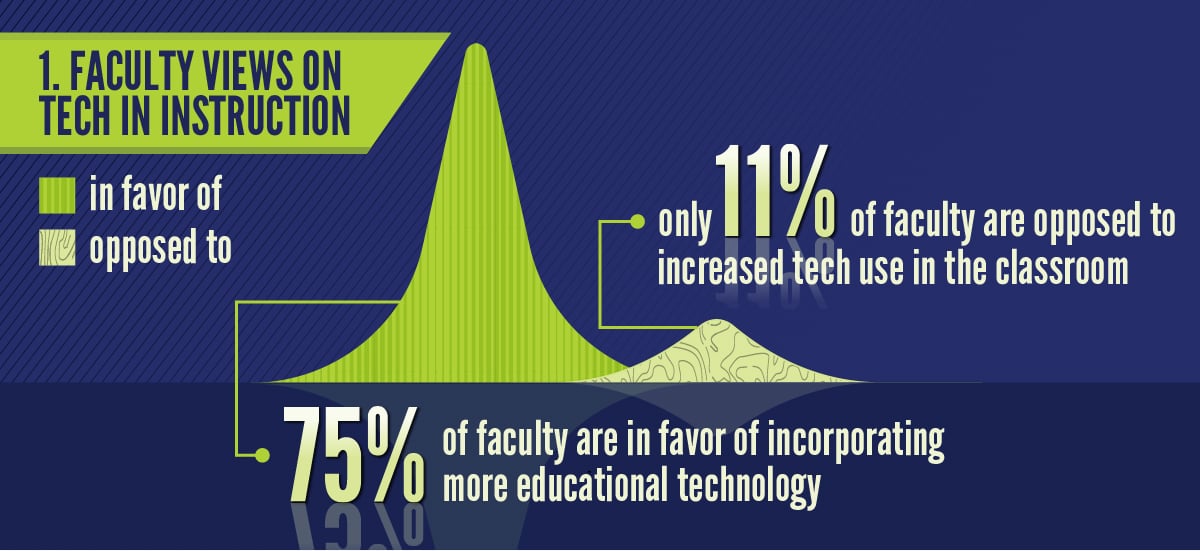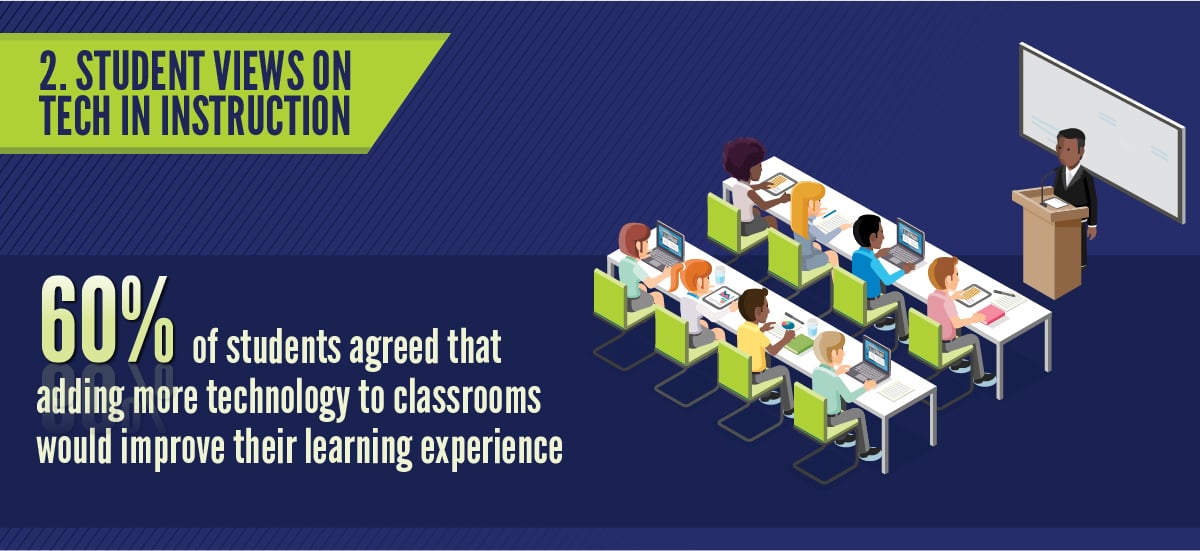It’s good to have powerful talking points on hand when you’re engaged in a campus discussion about the benefits of digital innovation or educational technology. Many people have strong views about the role technology should play in education — and in our lives. Faculty can be especially strident about anything they fear might harm instruction, including digital course materials.
Myths and fears about ed tech can frustrate anyone trying to bring innovation to campus. College store professionals are often asked how to lower student costs while providing services that boost success. That’s a tall order on its own. But it’s especially tough if influential campus stakeholders voice opposition to free or lower-cost digital textbook formats.
1. Tech-averse luddites are in decline on campus: 75 percent of faculty want ed tech use to increase
Yes, those with the most negative views of any kind of change can be the most vociferous. Loud, rigid remarks can create the illusion that naysayers are powerful and numerous. Just look at the effect a handful of dour reviews can have on the success of anything from a television show to an online retail offering. But research suggests that tech-averse faculty shouldn’t thwart any college’s efforts to innovate for the sake of serving students better.
Here’s the reality: luddite teachers are a tiny minority on most campuses. Only 11 percent of the over 2,000 faculty who responded to the 2018 Inside Higher Education Survey of Faculty Attitudes on Technology said they opposed increased tech use in the classroom. Some of these people may be fearful or even lazy. Some may be brilliant teachers and scholars whose classrooms provide students with a positive respite from the tiny screens that absorb so much of their lives. Even luddites have something to offer on campus. But that doesn’t mean students don’t benefit from increased tech use in general — especially if it lowers costs and makes education more accessible to all.
Academia moves at a slower pace than technological change. For those opposed to classroom tech, it may seem like only yesterday that colleges started asking teachers to keep grades and syllabi in those new-fangled digital learning management systems. In truth, LMS technology started to take off about a decade ago, and it’s only grown more streamlined and effective since then.
Now, most students couldn’t imagine college without an LMS. That’s increasingly the case for faculty, too. More than 80 percent of those IHE surveyed said they use the campus LMS almost always. This suggests the number of teachers who resist such changes is declining. That’s likely to be the case with those who reject all forms of increased technology use, including eBooks, courseware and assessments.
2. Most students say ed tech increases their engagement and learning
Student perceptions matter to everyone on campus, including faculty. After all, many colleges depend on healthy enrollment and retention for survival. If students don’t believe a school serves them well, they may take their tuition dollars elsewhere.
Faculty aren’t typically involved with the financial side of the institution. But they still care what students think. When students say that a teaching technique helped them — or complain that something confused them — many teachers take that to heart.
Recent data from Barnes & Noble College shows that students support increased technology usage in the classroom. Over half of students surveyed at more than 700 schools said that they believe increased classroom tech would improve their learning experience. Meanwhile, nearly a quarter said they thought their school’s ed tech was “insufficient,” according to the BNC report Inspire Evolution: Increasing Faculty Technology Use in Higher education.
Beyond that, new data from McGraw Hill Education supports digital innovation in higher education, particularly with course materials.
According to MHE:
>>62% of students said that digital learning tech is “extremely” or “very” helpful with exam preparation.
>>66% agreed that digital learning technology helps them complete assignments
However diverse the campus, most educators want to see students succeed. Finishing assignments and performing well on exams are essential to every student's educational goals. Data that shows how educational technology, including digital texts, helps more students stay in school and graduate can have a powerful impact on a variety of campus stakeholders, including faculty.
3. There’s a high concentration of early-adopters on campus
Would-be campus innovators who express despair over faculty reluctance to adopt digital may have spent too much time among the 11 percent who oppose increased learning technology. It’s true that efforts to persuade the tech-averse 11 percent are unlikely to yield progress. But there is a much larger population of teachers who are more than open to change. In fact, they embrace it.
A full one-third faculty said they consider themselves early adopters of educational technology in the IHE 2018. In the general population, only 13.5 percent of consumers consider themselves early adopters, according to an Oklahoma University study. That means the concentration of early adopters in higher education in almost three times that in the general population. What’s more, the campus early adopters outnumber the luddites three times over.
Such statistics should bring hope to those increase faculty tech use.
These pro-tech teachers are the ones who can help lead major changes in campus digital culture. They are also the ones who can serve as allies to collegiate retailers who want to lower student costs with affordable digital course materials. Faculty don’t always trust the word of administrators or vendors. But they listen to other teachers.
The early-adopters don’t need to persuade the tech-averse to join them. Their enthusiasm for educational technologies will persuade the quieter majority, the 75 percent who want to see increased tech usage in the classroom.
Next time you find yourself in conversation about digital solutions, remember these three talking points.
- Ignore luddites: Most faculty want more ed tech
- Research shows that students want more educational technology.
- One-third of faculty consider themselves early adopters. They can lead the way to campus-wide implementation of digital solutions.
Many collegiate retailers have talking points of their own when it comes to digital. We’d love to learn more about how you discuss digital textbooks with campus stakeholders and share that wisdom with our readers. Leave a comment below or share your experience with Foreword via email. The final installment of the Digital Text Classroom series will provide a first-hand faculty account of how students respond to inclusive access. It also discusses how reliance on temporary and part-time teaching labor in higher education affects digital evolution.
Click here to read the second. and here for the first Digital Text installment.

.jpg?width=1200&name=Headerdigital-classroom%20(1).jpg)


.jpg?width=1200&name=DataPoint3digital-classroom%20(1).jpg)




